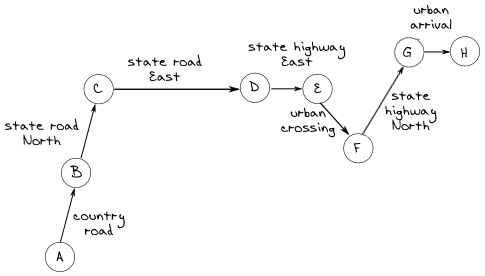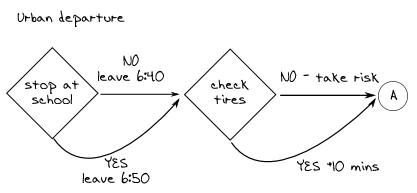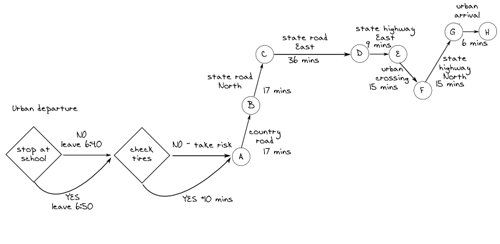Running Monte Carlo Simulations in PHP
One of the exciting things in the 1980’s was programming simulations to solve complex analytical problems, and one of the most useful techniques employed was running Monte Carlo simulations. The approach repeatedly runs a simulation many times over to calculate the most likely outcome.
Although PHP isn’t known as a scientific or research programming language, Monte Carlo simulations can easily be written in a PHP web app. In this article, I’ll show you how.
Key Takeaways
- Monte Carlo simulations, a technique used to solve complex analytical problems, can be effectively run in PHP, a language not typically associated with scientific or research programming.
- The author demonstrates how to model a real-world problem in PHP, using a trip with various stages and potential delays as an example, and shows how to write the basic code to understand potential variations in the plan.
- The article explains how to add randomness to the model to account for uncertainties, using PHP’s rand() function to define a safety margin for each event and assign probabilities to decisions.
- The author introduces Monte Carlo simulations as a way to establish a confidence level for the feasibility of the plan, by running a large number of trials and calculating the ratio of successful outcomes to total trials.
- The author concludes by highlighting the power of PHP for creating both simulation logic and a user-friendly web interface, and encourages the exploration of scientific computation functions in PHP.
A Real-World Problem
The day before yesterday I had a meeting at 9:00 AM about 100 miles away from my home. At 6:30 I was awake and dressed, and while having breakfast I began to work out the next couple of hours on a notepad. I obviously wanted to arrive at the meeting safely and on time, so I started sketching the drive split in eight stages: urban departure, country road, state road northbound, state road eastbound, state highway eastbound, urban crossing, state highway northbound, and urban arrival. The sketch more or less looked like this:

My wife had filled the gas tank the evening before and ideally I could drive straight out to the country road. The tires seemed alright when I looked at them, but doubt whether or not to make a 10 minute detour to properly check their pressure hounded me. If I stopped and checked the tires, I’d be certain of their pressure. Otherwise, I’d have to travel with the uncertainty. Poor tire pressure could have an effect on my driving stability and speed.
I could leave as early as 6:40 but then my wife would have to take our daughter to school instead of going straight to work. If I waited another 10 minutes, I could be at the school as their gates opened for the morning and spare my wife the trouble. The school is on my way out of town so there’d be no significant added travel time.
I went back to my drawing and added the following:

Sipping my second cup of coffee, I stood by the window. A clear dusk sky and brisk morning breeze agreed with the perfect day forecast on my smartphone which made me believe the drive would be a fast one. To finish my planning, I drew from past experience and wrote down the estimated drive times:

The expected time en route was 115 minutes (1 hour 55 minutes), which I could cover non-stop. My ETA was 8:35 if I left straight for the road and 8:55 if I decided take my daughter to school and check the tires.
But no plan survives its first encounter with the enemy! For some mysterious reason, many other parents decided to drop their children off at school earlier than usual, and I had lost more than 5 minutes on what was planned to be a quick detour. Knowing that my baseline was already compromised, I decided to skip the tire check and drive straight to the country road.
I reached the road actually five minutes sooner than the original worst case estimate and the drive went well until, somewhere between milestones B and C, I ran into dense fog which reduced my visibility. This reduced my average speed and made it harder to overtake the slow but long trucks.
The urban traffic in the town I had to cross was much lighter than usual and it didn’t take me more than 10 minutes to go across. And a few miles onto state highway southbound the fog lifted so I was able to drive at the full legal speed. But when I approached my destination, I realized that some road work that was in progress had blocked the exit I planned to take. This added another 10 minutes to my travel time and needless to say I arrived late.
Modeling the Trip in PHP
I believe most PHP coding is dedicated to profit and non-profit business websites. But PHP can be a fine tool for scientific research and might as well be easier to teach non-professional programmers, like engineers and scientists, than other languages like my beloved Python.
Let’s write the basic code that will help me understand how much earlier or later I could have arrived at the meeting if one or more stages of my plan varied substantially from their baseline estimates. We can begin to model the trip as follows:
<?php
class MyTrip
{
protected $departureTime;
protected $meetingTime;
protected $travelTimes;
public function __construct() {
$this->setDepartureTime('0640');
$this->setMeetingTime('0900');
// travel times in minutes between milestones
$this->setTravelTimes(array(
'AB' => 17,
'BC' => 17,
'CD' => 36,
'DE' => 9,
'EF' => 15,
'FG' => 15,
'GH' => 6
));
}
// for convenience convert time string to minutes past
// midnight
protected static function convertToMinutes($timeStr) {
return substr($timeStr, 0, 2) * 60 +
substr($timeStr, 2, 2);
}
public function setDepartureTime($timeStr) {
$this->departureTime = self::convertToMinutes($timeStr);
}
public function setMeetingTime($timeStr) {
$this->meetingTime = self::convertToMinutes($timeStr);
}
public function setTravelTimes(array $travelTimes) {
$this->travelTimes = $travelTimes;
}
public checkPlan($stopAtSchool = true, $checkTires = true) {
// ...
}
}Plans must be feasible, and the suitable criteria to judge this one is whether the sum of all times plus the earliest departure time is less than or equal to the time of the meeting. That is what the checkPlan() method determines:
<?php
public checkPlan($stopAtSchool = true, $checkTires = true) {
// calculate the sum of travel times between milestones
$travelTime = array_sum($this->travelTimes);
// add delay if dropping kid off at school
$schoolDelay = ($stopAtSchool) ? 10 : 0;
// add delay if checking tire pressure
$tiresDelay = ($checkTires) ? 10 : 0;
// find the total schedule baseline
$meetingArriveTime = $this->departureTime + $travelTime +
$schoolDelay + $tiresDelay;
// does the traveller make the meeting on time?
$arriveOnTime = $meetingArriveTime <= $this->meetingTime;
return array($meetingArriveTime, $this->meetingTime,
$arriveOnTime);
}Now all we have to do is create an instance of the class and ask it to check my plan:
<?php
$trip = new MyTrip();
print_r($trip->checkPlan());Given the default values, the above will output that my original plan was okay:
Array
(
[0] => 535
[1] => 540
[2] => 1
)
I should be there 535 minutes after midnight, and the meeting takes place 540 minutes after midnight. According to the baseline, I’ll arrive at the meeting at 8:45 AM, just 5 minutes before the scheduled time!
But what about the inevitable variations? How can we account for the uncertain elements?
Monte Carlo and Adding Randomness
In a very simplistic way we can define a safety margin to every event and say it could happen 10% earlier and 25% later of the scheduled time. Such margins can be randomly added to the departure delays and every travel time between milestones by multiplying each factor by rand(90,125)/100.
We can also assign a 50% probability for both decisions to drop my daughter off at school and to check the tires. Again the rand() function can helps us:
$this->checkTires = rand(1, 100) > 50;Putting it all together, we can define a method checkPlanRisk() to computer whether or not I can arrive on time given the many uncertainties that stand in my way:
<?php
public function checkPlanRisk() {
// adjust and sum travel times between milestones
$travelTime = 0;
foreach ($this->travelTimes as $t) {
$travelTime += $t * rand(90, 125) / 100;
}
// decide whether to drop kid off at school and randomly set
// the delay time
$schoolDelay = 0;
if (rand(1, 100) > 50) {
$schoolDelay = 10 * rand(90, 125) / 100;
}
// ditto for checking tires
$tiresDelay = 0;
if (rand(1, 100) > 50) {
$tiresDelay = 10 * rand(90, 125) / 100;
}
// find the total schedule baseline
$meetingArriveTime = $this->departureTime + $travelTime +
$schoolDelay + $tiresDelay;
// does the traveller make the meeting on time?
$arriveOnTime = $meetingArriveTime <= $this->meetingTime;
return array($schoolDelay, $tiresDelay, $meetingArriveTime,
$this->meetingTime, $arriveOnTime);
}The question now is, how likely is the traveller to arrive on time given the initial conditions and the assumed uncertainty? Monte Carlo simulations answer this by running a large number of times and computing a “level of confidence”, defined as the ratio of arrivals on time to total number of trials.
If we run this method a sufficient number of times and record how often the traveller arrives on time, we can establish some sort of margin of confidence whether the trip is feasible as planned.
<?php
public function runCheckPlanRisk($numTrials) {
$arriveOnTime = 0;
for ($i = 1; $i <= $numTrials; $i++) {
$result = $this->checkPlanRisk();
if ($result[4]) {
$arriveOnTime++;
}
echo "Trial: " . $i;
echo " School delay: " . $result[0];
echo " Tire delay: " . $result[1];
echo " Enroute time: " . $result[2];
if ($result[4]) {
echo " -- Arrive ON TIME";
}
else {
echo " -- Arrive late";
}
$confidence = $arriveOnTime / $i;
echo "nConfidence level: $confidencenn";
}
}Creating a new instance of MyTrip and asking it compute the confidence level for 1,000 trials is straightforward:
<?php
$trip = new MyTrip();
$trip->runCheckPlanRisk(1000);The output will be a screen print-out of 1,000 entries like this:
Trial: 1000 School delay: 0 Delay tires: 11.3 Enroute time: 530.44 -- Arrive ON TIME Confidence level: 0.716
With the parameters above, the confidence level seems to converge to 0.72, which roughly indicates that the traveler has 72% chance of getting to the meeting on time.
Grosso modo, Monte Carlo relies on the convergence of the mean result of a sequence of identical experiments. The mean result is also known as the expected value and can be thought of as the probability of a desired result occurring. Of course this is quite an old concept and such simulations have been done a long time before the arrival of the digital computer.
Conclusion
Today, we have immensely powerful resources at our disposal and a very convenient language like PHP which can be used to create both the simulation logic and a user friendly web interface for it. With a few lines of code, we created a model and applied Monte Carlo simulations with it, producing an intelligible result useful for business decisions. This is a field worth exploring and it would be nice to see some scientific computation functions added to PHP so scientists and engineers could take advantage of this versatile, non-nonsense language.
Code for this article is available on GitHub.
Image via Fotolia
Frequently Asked Questions (FAQs) about Running Monte Carlo Simulations in PHP
What is the significance of Monte Carlo simulations in PHP?
Monte Carlo simulations are a powerful tool for making predictions and understanding the potential outcomes of uncertain processes. In PHP, they can be used to model complex systems and scenarios that would be difficult to predict otherwise. For example, they can be used in financial forecasting, risk management, and optimization problems. The simulations work by running a large number of trials, each with randomly generated inputs, and then analyzing the distribution of results to understand the range of possible outcomes.
How can I optimize the performance of my Monte Carlo simulations in PHP?
There are several ways to optimize the performance of your Monte Carlo simulations in PHP. One method is to use a faster random number generator. PHP’s built-in rand() function is not the fastest option available, so you might consider using a different generator such as mt_rand() or openssl_random_pseudo_bytes(). Another method is to use parallel processing to run multiple simulations at the same time. This can significantly speed up the overall runtime of your simulations, especially if you are running a large number of trials.
Can I use Monte Carlo simulations for web development?
Yes, Monte Carlo simulations can be used in web development, particularly in areas such as performance testing and optimization. For example, you can use a Monte Carlo simulation to model the behavior of users on your website, and then use the results to optimize your site’s performance. This can help you identify potential bottlenecks and areas for improvement, and make data-driven decisions about how to improve your site.
How can I compile PHP code online?
There are several online platforms that allow you to compile and run PHP code directly in your browser. These include onlinePHP.io and W3Schools’ PHP compiler. These tools can be useful for testing and debugging your code, especially if you don’t have a local PHP environment set up on your computer.
What is data observability and how does it relate to Monte Carlo simulations?
Data observability refers to the ability to monitor and understand the state of your data at any given time. This is particularly important in Monte Carlo simulations, as the quality of your results is directly dependent on the quality of your input data. By implementing data observability practices, you can ensure that your simulations are based on accurate, up-to-date data, and that any issues with your data are quickly identified and resolved.
How can I use Monte Carlo simulations for job forecasting in web development?
Monte Carlo simulations can be used to model and predict trends in the web development job market. For example, you could use a simulation to predict the demand for different web development skills over time, based on factors such as technological advancements, industry trends, and economic conditions. This can help you make informed decisions about which skills to focus on developing, and which job opportunities to pursue.
What are the best practices for running Monte Carlo simulations in PHP?
Some best practices for running Monte Carlo simulations in PHP include using a fast random number generator, implementing parallel processing to speed up your simulations, and ensuring that your input data is accurate and up-to-date. It’s also important to run a sufficient number of trials to ensure that your results are statistically significant. Finally, remember to analyze and interpret your results carefully, as the output of a Monte Carlo simulation is a distribution of possible outcomes, not a single definitive answer.
Can I use Monte Carlo simulations for website design and hosting services?
Yes, Monte Carlo simulations can be used in the context of website design and hosting services. For example, you could use a simulation to model the performance of your website under different traffic conditions, or to predict the cost-effectiveness of different hosting options. This can help you make data-driven decisions about how to design and host your website.
How can I learn more about Monte Carlo simulations in PHP?
There are many resources available online to help you learn more about Monte Carlo simulations in PHP. These include tutorials, online courses, and documentation on the PHP website. You can also find many examples and case studies of Monte Carlo simulations being used in real-world applications, which can provide valuable insights and inspiration.
What are the potential challenges of running Monte Carlo simulations in PHP?
Some potential challenges of running Monte Carlo simulations in PHP include performance issues, particularly if you are running a large number of trials, and the need for accurate, up-to-date input data. It can also be challenging to interpret the results of a Monte Carlo simulation, as the output is a distribution of possible outcomes, not a single definitive answer. However, with careful planning and implementation, these challenges can be effectively managed.
Armando Jeronymo has a B.Sc. in Electronics Engineering from Rio de Janeiro's Ursuline University and a US Associate degree in Risk Management. He started coding in a TI-59 calculator in the early 80's. He then learned and forgot Sinclair Basic, Fortran, Algol and MS Basic. For ten years he did not write code but worked with insurance and reinsurance in his native Brazil and London. Then he went back to programming to find out everything was different. He began by getting to know HTML to create some material on aviation instruction. He then learned Delphi's Pascal in order to create some financial applications. He began experimenting with server-side languages about the turn of the Century, first with ASP but soon moving to PHP. He wrote his first MySQL web application in about 2004. He switched to Linux in 2005 (Ubuntu 5.10 to be more exact) and has been developing LAMP systems since then. He is a Private Pilot and, whenever possible, a FlightGear flyer. He loves classical music and jazz (including Bossa Nova) and old movies. Besides computing he is professionally interested in business management and a follower of Peter Drucker's teaching. Married and father of a girl he is also an active member of his Rotary Club.
